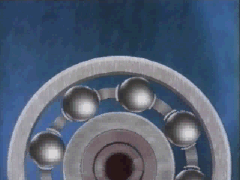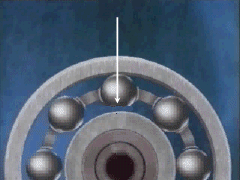 |
|
|
|
In the Forums... |
Posted: April 17, 2000 Written by: Tuan "Solace" Nguyen Areal Density: Areal density is the amount of data that can be packed in a square-inch of space of a platter. Each platter stores information in tracks. You can think of the tracks as circular rings that are etched out the platter – magnetically of course. And in these rings, the data bits are recording linearly. The more bits that are packed along the tracks, the more data can be stored. Currently, Seagate holds the record for areal density – 16.1Gb (gigabits) per square inch. So why can’t a company keep packing more gigabits per square inch? This is because of physical limitation as well as electromagnetic limitations. To make a disk platter, you have to take a virtually featureless disk (meaning that it has no markings, particles, dents on it – perfectly smooth) and embed microscopic magnetic marks on it. To increase areal density, you have to make those marks smaller in size and decrease the size of the read/write device. But it isn’t as easy as words. The smaller the bits, the harder it is to be read because of signal intensity. Spindle: Each platter is stacked together on top of a spindle. The motor that spins the platters rotate at a specific speed. The most common is 5,400RPM (Rotations Per Minute). High-end hard drives that are used in workstations and or servers can spin at 7,200RPM, 10,000RPM or even 15,000RPM. The faster the platters rotate, the faster the read/write head can obtain data – the destination sector arrives under the read/write head faster. The spindle motor uses ball-bearings to rotate around. Using ball bearings produces faster and smoother operation than brush-less motors. The spindle is one of the most sensitive parts of the hard drive. If it receives a significant amount of shock, a bearing may be shot lose from the bearing ring that holds the bearings.   Left: Good bearing. Right: Loose bearing. Actuator: The actuator is responsible for moving actuator arms which hold the read/write heads precisely with a specific track and sector. The actuator is one of the most important parts of the hard drive that determine the speed of the drive and how many bits it can pack on its platters. The actuator must align the read/write head precisely, if not, data read and write errors can occur. You can picture the actuator movement like a F-20 fighter jet. Now imagine that this jet is moving at an unbelievable mach 5, one inch off the ground and being able to stop on a blade of grass. Development in actuator technology is a constant affair. To be able to seek information faster, the actuator must be able to move increasingly faster while retaining complete accuracy. However, this is not an easy task. The faster everything moves, the more damage can occur if the read/write heads ever actually come in contact with the platters. Below is a animation of an actual actuator arm in motion – there are two arms per platter, one above and one below.  |
||
|
| |||
|---|---|---|---|